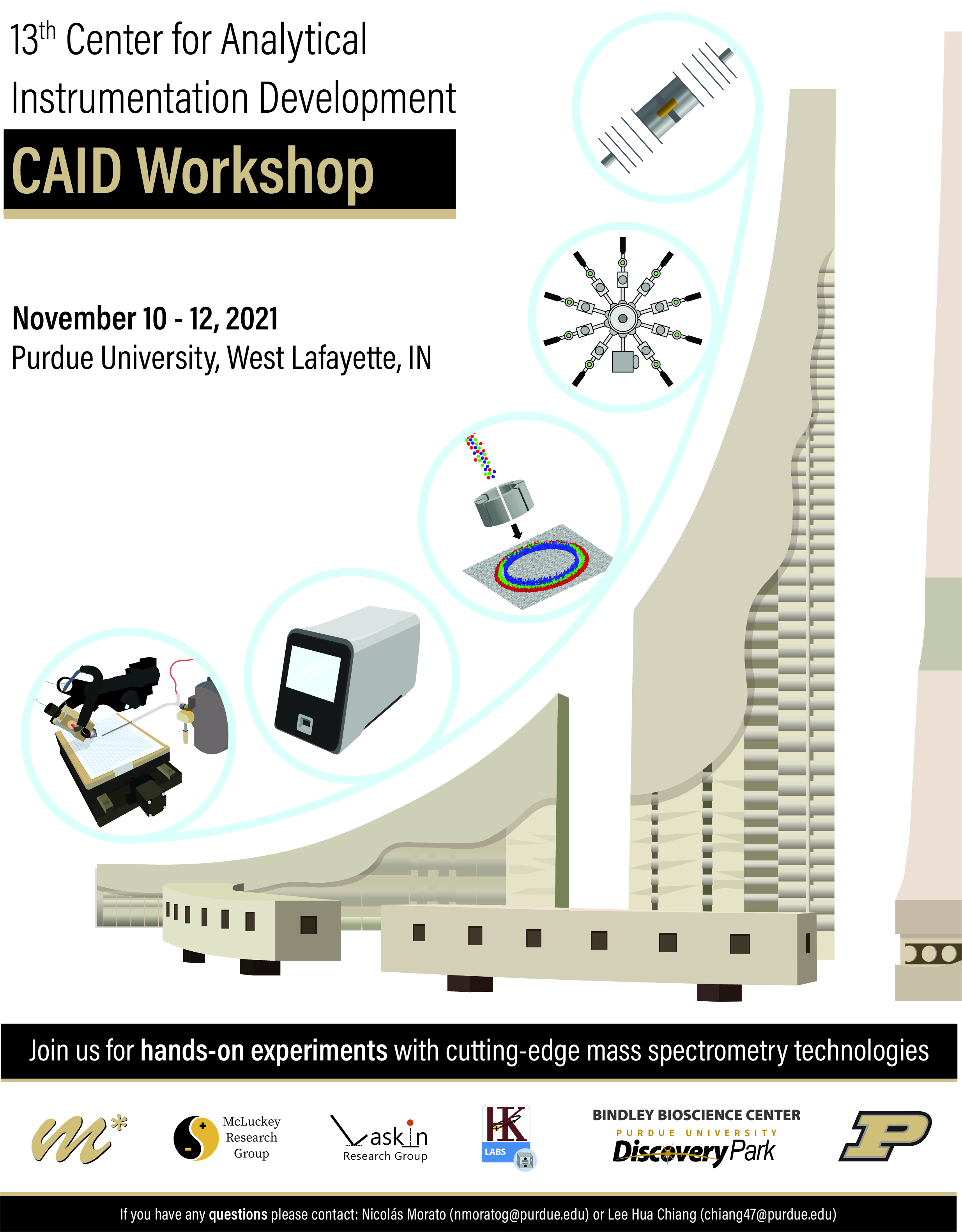2021 Annual Meeting
November 10–November 12, 2021
Click Here to Register!
Event Flyer
Experiments
This year we have seven hands-on experiments with cutting-edge mass spectrometry technologies from four research groups at Purdue University. Each experiment has a duration of about 25 minutes, and each visitor will be able to visit as many experiments as allowed by the time availability selected during registration. Experiments will take place across different locations on Purdue campus: the R. B. Wetherill Laboratory of Chemistry, the H. C. Brown Laboratory of Chemistry, the Hall for Discovery and Learning Research and the Bindley Bioscience Center. Below are short descriptions of all the experiments.
Complex mixture analysis by two-dimensional mass spectrometry using a miniature ion trap
Developments in ambient ion sources have allowed mass spectrometers to make impactful measurements at the point of action. Although ambient ionization sources have garnered significant attention, less attention is paid to other aspects of the mass spectrometry experiments. This experiment demonstrates how developments in the mass analyzer used can be tailored to complement the ion source being employed thereby improving chemical identification. Specifically, this experiment will use a miniature mass spectrometer and the recently developed two-dimensional mass scan to simultaneously identify a mixture of proscribed drugs.
Using a rotating wall mass analyzer to explore broad m/z ranges
Participants will have a first-hand experience with a custom soft-landing mass spectrometry instrument that uses a rotating wall mass analyzer (RWMA), a device that provides a uniform rotating electric field. The RWMA is a simple mass analyzer that separates a broad range of ions from low to extremely high m/z. When an ion beam passes through the device, different m/z ions deposit onto a surface with a ring-shaped pattern. Lower m/z ions deposit in rings with larger radii whereas larger m/z ions deposit in rings with smaller radii. The higher m/z range can be explored simply by lowering the frequency of the rotating electric field. During the workshop, participants of CAID will control the frequency of the RWMA and observe in real-time how this determines the radii of deposition of each m/z using an ion CCD detector.
High-throughput desorption electrospray ionization mass spectrometry for organic reaction screening and label-free biological assays
Automation of high-performance liquid chromatography tandem mass spectrometry coupled with a heated pulsed-valve reagent inlet system
The purpose of this experiment is to demonstrate a method for the identification of functionalities in unknown analytes via diagnostic gas-phase ion-molecule reactions based on tandem mass spectrometry. This novel method consists of a data-dependent scan method which allows the automated isolation of the analyte ions and the monitoring of their reactions without prior knowledge of the analyte ion m/z values or when the analytes elute from the HPLC column. All isolated ions are allowed to react with the neutral reagents that are temporarily introduced, one after the other, into the ion trap by a heated pulsed-valve inlet system. The product ions are detected and used to verify the functionalities present in the analyte ions.
Accelerated Katritzky reaction at the gas/solution interface
Pyridinium salts are valuable structural units in medicinal chemistry and organic synthesis. These salts can be easily and rapidly synthesized through the Katritzky reaction between triphenylpyrilium (TPP) compounds and primary amines, a reaction that is significantly accelerated at gas/solution interface. In this experiment participants will explore the reaction acceleration phenomenon using a TPP salt and several amines. In the case of volatile amines (e.g. butyl amine), acoustically levitated droplets containing the TPP reactant will be exposed to amine vapor allowing an efficient gas/solution interfacial reaction (more than 50% conversion achieved after 1 minute). For non-volatile amines (e.g. p-anisidine), thin films containing both reactants, which are generated by drop casting and solvent evaporation, will be utilized to generate large surface-to-volume ratios and thus full conversion after 20 minutes.
Simultaneous isolation of nonadjacent m/z ions using mirror switching in an electrostatic linear ion trap
Simultaneous isolation of ions of disparate mass-to-charge (m/z) ratios will be demonstrated via appropriately timed pulsing of entrance and exit ion mirrors in an electrostatic linear ion trap (ELIT) mass spectrometer. Simultaneous isolation takes advantage of both the rapid spatial separation of ions and the periodic nature of ion overlap in a closed path MR-TOF device. Mirror switching isolation pulses can be timed to coincide with overlapping events and because the ions of interest are spatially overlapped during the isolation event, they can be isolated from contaminant ions simultaneously. The time in which the overlap event occurs can be determined on the basis of ion frequencies and beat periods within the device.
Multiple reaction monitoring profiling for the determination of food and beverage authenticity and origin
Schedule
November 10th - 12th
Several time blocks are provided during the three workshop days to accommodate the time availability of the participants. The days and time blocks can be selected during registration. Participants will be provided with personalized schedules according to their time availability and the experiments they are most interested in. The schedules will be sent via email in advance of the workshop.
Questions?
If you have any questions please contact Nicolás Morato (nmoratog@purdue.edu) or Lee Hua Chiang (chiang47@purdue.edu).

